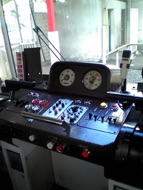tram vibrations


The TramVibration Project
Toshiya Tsunoda and Haco




The TramVibration Project
角田 俊也 + HACO
2006年12月28日 12:03 - 13:46
阪堺電車内、恵美須町 - 浜寺駅前一往復
Date: December 28, 2006
Place: Inside a tram on a round trip from Ebisu-cho to Hamadera Ekimae on the Hankai Line (12:03 - 13:46) in Osaka, Japan
Toshiya Tsunoda captured solid vibrations using a piezo-ceramic sensor and a stethoscope,
and Haco used her "stereo bugscope" (two inductive microphones) system to catch electromagnetic sounds.
The first edition of work was used for the View Masters Osaka-Melbourne Remix Exhibition in Osaka in February 2007. (The video documentary for the exhibition 13:28)
The TramVibration Project
Toshiya Tsunoda + Haco
1.作品のアイデア
1. The idea behind the work
互いの作品について以前から興味を持っていたという角田俊也とHaco。「聴こえない振動の環境版をつくる」というコンセプトで音の観察と抽出によるコラボレーションを行い、録音するということで意気投合した。今回の路面電車はそのために最高のロケーションである。
Tsunoda and Haco have admired each other's work for some time. Both of them thought it would be interesting to do a collaboration involving the observation and documentation of sound. The concept was to create environmental art with normally inaudible vibrations, and the tram seemed like the perfect location for the project.
2.録音方法
2. The recording method
<角田>
圧電セラミック・センサーマイクと超小型無指向性マイクのヘッドを聴診器に差し込んだものを用意し、両者とも固体を伝わる振動を採集する。
Tsunoda:
I used a piezo-ceramic sensor, and a stethoscope, which I inserted in the head of an ultra-compact, nondirectional microphone. Both microphones picked up solid vibrations.
<Haco>
電磁波をキャッチする"ステレオ・バグスコープ"(内部に磁気コイルが入った2つの誘導性マイクロフォン、いわゆる黒電話用ピックアップ)を使用し、ふだんは聞こえない部類の音を拾う。
Haco:
I used my "stereo bugscope" system (two inductive microphones, which have magnetic coils in them − also called "analog telephone pickups") to catch electromagnetic waves and record faint audio signals that are normally inaudible.
3.印象深い音
3. Impressive sounds
<角田>
金属、ゴム、ガラスなど種類や形状によって、そこで形作られる振動モードが異なる。路面電車はその駆動系の振動が支配的で、場所によって大きな変化は無いが、視覚に頼らず空間を探る経験が逆に普段より意識された。
Tsunoda:
The mode of each vibration is different according to the type and shape of the metal, rubber, or glass. Inside the tram, the vibration of the machine driving was the most dominant sound, and though it didn't vary that much from spot to spot, I grew more aware than usual by exploring the space without relying on what I could see.
<Haco>
バグスコープでさまざまな制御系、駆動系の音がキャプチャーできた。常に流れているブーンというのがインバータ電源の音、ブポッ、ブポッというのはハンドル切り換え、ブレーキの制御、床からカシャカシャいうのはエンジンの駆動音、線路からの擦音を磁気漏れで拾っている模様、高周波はデジタル機器にも似た電子回路系の音、を検出できたのではないかと推測している。
Haco:
My "bugscope" captured many kinds of sounds related to controlling and driving the tram. The droning power inverter, the clacking of the steering system, the sound of the engine-drive coming from the floor as the brakes were applied, the sound of friction between the tram and the rails that was amplified due to magnetic leakage, and the sound of the high-frequency waves from the electric circuits, which sounded something like a digital device. Those are some of the electromagnetic sounds I think I detected.
4.録音する行為とそれが及ぼす音への影響
4. The act of recording and its effect on sound
<角田>
この電車は2つ操縦席があり、両方向に動く車体はシンメトリーの形をしている。1本の線路上を往復し、1台の電車が走ることによってシンメトリーの形が線路上に拡大されたように思える。線路自体が楽譜のような印象を受けた。
Tsunoda:
There were two control compartments in the tram. The tram had a symmetrical design, making it possible to drive in either direction. As we made a round trip on it, I imagined
the symmetrical form expanding as the tram traveled down the rails. I had the impression that the tram itself was like a musical score.
<Haco>
最新車両を使用した故か、空気中も電磁系統の音が飛び込んでくる。これは予想以上の感度だった。色鮮やかな電磁の海のような状態に浸り、「全身録音機」になって、とても濃い時間と空間の移行を体験した。
Haco:
Perhaps because we used the latest model of tram, the electromagnetic sounds seemed to fly through the air. I hadn't imagined that I'd be able to detect so much. It was like being immersed in a colorful sea of electromagnetic sound. I felt like a full-body recorder and experienced a very intense movement through time and place.
5. 録音されたソースについて
5. The recorded sources
それぞれの振動系と電磁波系の採集音がミックスされた作品ではあるが、通常の記述方法とは異なるので奇妙な記録物になるだろう。構成された記録物を聴くことによって、路面電車を単なる乗り物としてではなく、「ひとつの出来事」として見直す作業になるようにしたい。
Although the work is a mixture of vibrations and a collection of electromagnetic sounds, because the manner of documenting the phenomena was unusual, our record of the trip is rather odd. In listening to the results, we hope that the tram will become more than a mere vehicle, and that listeners will come to view it as a kind of "event."
Photos: Yugi Yamada (camera & video editing)
Special thanks to: Takashi Kojima (director of Osaka Arts-Aporia), Joe Ueda (video recording), Hankai Tramway Co.,Ltd, City of Osaka, and Jane Hindson
"TramVibration" Haco and Toshiya Tsunoda (CD)
Duration 34:36
Released in November 2013





© Haco 2025. All rights reserved.

